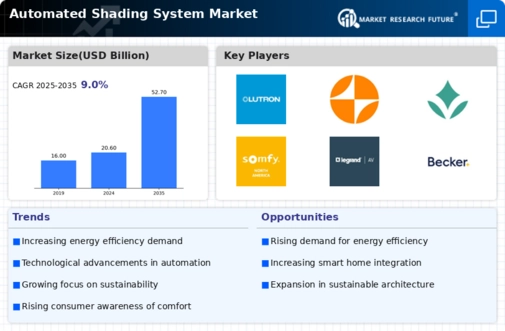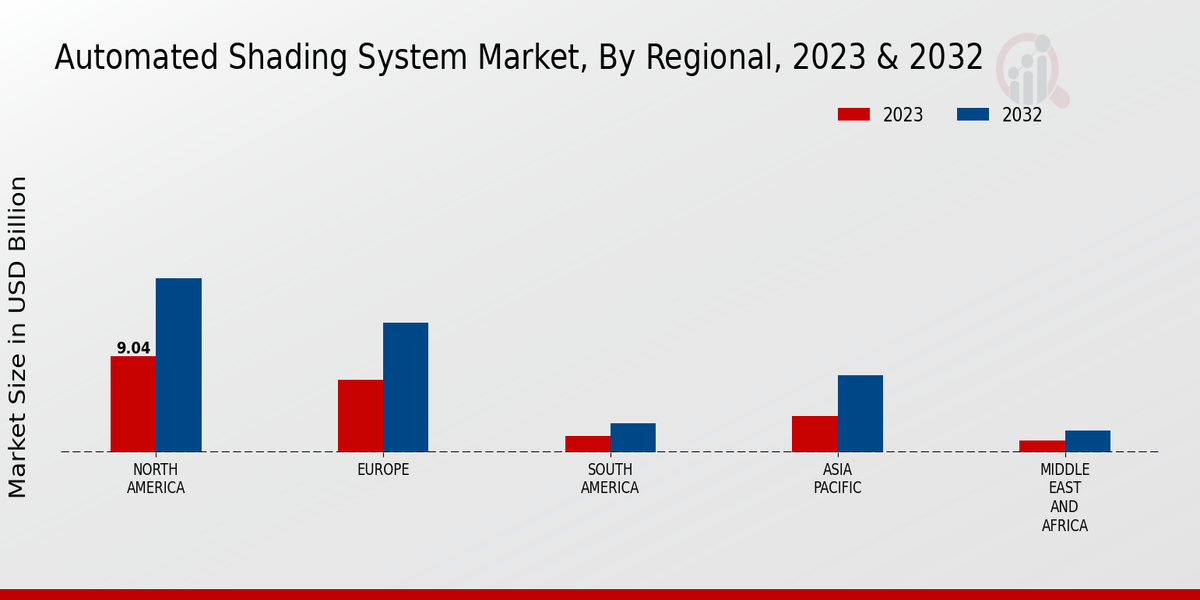Market Growth Projections
The Global Automated Shading System Market Industry is poised for substantial growth, with projections indicating a market value of 20.6 USD Billion in 2024 and an anticipated increase to 52.7 USD Billion by 2035. This growth trajectory reflects a compound annual growth rate (CAGR) of 8.92% from 2025 to 2035. The increasing adoption of automated shading systems across various sectors, driven by factors such as energy efficiency, technological advancements, and regulatory support, suggests a robust market outlook. These figures illustrate the potential for significant investment and innovation within the industry.
Growing Demand for Energy Efficiency
The Global Automated Shading System Market Industry is witnessing a surge in demand for energy-efficient solutions. As energy costs continue to rise, consumers and businesses alike are increasingly seeking technologies that can reduce energy consumption. Automated shading systems, which adjust in response to sunlight, can significantly lower heating and cooling costs. For instance, studies indicate that these systems can reduce energy usage by up to 30 percent in commercial buildings. This trend is expected to contribute to the market's growth, with projections estimating the market value to reach 20.6 USD Billion in 2024, underscoring the importance of energy efficiency in driving market dynamics.
Increased Focus on Sustainable Architecture
Sustainability is becoming a central theme in architectural design, significantly influencing the Global Automated Shading System Market Industry. Architects and builders are increasingly incorporating automated shading systems into their designs to meet green building standards and certifications. These systems not only enhance aesthetic appeal but also contribute to energy savings and improved indoor comfort. The growing emphasis on environmentally friendly construction practices is likely to drive market expansion, as more projects aim for LEED certification and other sustainability benchmarks. This trend aligns with the projected CAGR of 8.92% from 2025 to 2035, indicating a strong commitment to sustainable architecture.
Technological Advancements in Smart Buildings
The integration of automated shading systems into smart building technologies is a notable driver in the Global Automated Shading System Market Industry. Innovations such as IoT connectivity and advanced sensors enhance the functionality of shading systems, allowing for real-time adjustments based on environmental conditions. This technological evolution not only improves user experience but also promotes sustainability by optimizing natural light usage. As smart buildings become more prevalent, the demand for automated shading solutions is likely to increase, contributing to a projected market growth to 52.7 USD Billion by 2035. This indicates a robust market trajectory fueled by technological advancements.
Rising Urbanization and Construction Activities
The rapid pace of urbanization is significantly impacting the Global Automated Shading System Market Industry. As urban populations grow, there is an increasing demand for new residential and commercial buildings, which often incorporate automated shading systems to enhance energy efficiency and occupant comfort. The construction boom in urban areas is likely to drive the adoption of these systems, as builders seek to meet the needs of modern consumers. This trend is expected to contribute to the market's expansion, aligning with the overall growth trajectory of the construction industry, which is projected to continue its upward momentum in the coming years.
Regulatory Support for Energy Efficiency Standards
Government regulations promoting energy efficiency are playing a crucial role in shaping the Global Automated Shading System Market Industry. Many countries are implementing stricter building codes and energy efficiency standards, which often include the use of automated shading systems. These regulations encourage the adoption of technologies that can reduce energy consumption and greenhouse gas emissions. For example, initiatives such as tax incentives for energy-efficient upgrades are motivating building owners to invest in automated shading solutions. This regulatory support is expected to bolster market growth, as compliance with energy standards becomes increasingly mandatory in the construction sector.











